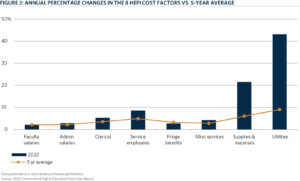Each year, the Commonfund Higher Education Price Index provides a snapshot of colleges’ expenses. And according to this year’s data, costs have risen across the board.
Based on the report, inflation for U.S. higher education institutions rose 5.2% in the fiscal year 2022, which indicates a drastic increase since the previous year’s 2.7% rate. Comparably, spending rates haven’t been this high since FY2001 when the figure was at 6%.
“The highest annual increases since the inception of HEPI in FY1961 generally occurred in the late 1970s and early 1980s,” the report reads. “The highest rate, 10.7 percent, was recorded in FY1981; contiguous years before and after were the only other years above 9.0 percent.”
However. the last time spending levels exceeded 5% was in FY2008. In FY2022, costs rose in all eight components HEPI tracks each year: faculty salaries, administrative salaries, clerical salaries, service employee salaries, fringe benefits, miscellaneous services, supplies and materials, and utilities.
Looking at FY2022’s numbers, there were year-over-year changes in the following areas:
- Administrative salaries: rose nearly 3% (2.9%)
- Clerical costs: rose 5.2%
- Fringe benefits: rose 2.6%
- Miscellaneous services: saw the highest growth at 4.3%
“HEPI is an inflation index designed specifically for use by institutions of higher education,” the report reads. “Compiled from data reported by government agencies and industry resources, HEPI measures the average relative level in the price of a fixed market basket of goods and services purchased by colleges and universities each year through current fund educational and general expenditures, excluding research.”
Historically, the cost of utilities has been the most vital component in the measurement. Over the last decade, utilities saw double-digit price increases or decreases six separate times.
Take a look at the annual percentage changes vs. the five-year average:

In terms of faculty salaries, the most heavily weighted component of HEPI, they rose 2.1%, which is moderately lower than the 2.3% average annual increase over the last decade. Most notably, when the data is broken down by institution, faculty among private institutions rose higher (2.2%) than their peers in public higher ed institutions (1.8%).
As we narrow the scope to public institutions, “faculty salaries at doctorate-granting institutions increased 1.9% and 1.7% at master’s degree-granting institutions,” according to the report. Among private colleges, as mentioned previously, doctorate-granting institutions increased salaries at a rate of nearly 4% (3.8%). Among master’s-granting institutions, that number rose by only 0.5%, and 0.7% at baccalaureate institutions.
More from UB: Is betting big on graduate school enrollment growth a major risk for higher ed?






